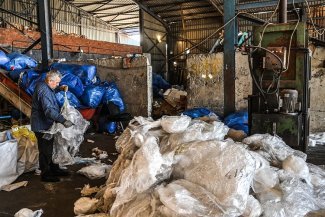Chinese engineers overlook the site of the new Peljesac Bridge, which is scheduled for completion in January 2021. It is the first project party financed by the European Union to be built by a Chinese company.
“It was a fascinating spectacle, a scene that nobody had ever witnessed before in Croatia. A huge ship arrived at the bay, carrying the largest crane in the world. Then it sank ten metres under the sea level, unloading the crane and other two smaller boats,” remembers Ivo Jerkovic, a 24-year-old hotelier. “The whole village was outside, people were standing at the pier or watching from their windows and balconies,” he says.
The crane and the boat have since become part of the landscape in the bay of Komarna, a village in southern Croatia. During the winter, only 60 people live in this hamlet, which is so small that it doesn’t even have any shops, restaurants or schools. Yet in recent months, Croatian prime minister Andrej Plenkovic, various governmental officials and numerous TV crews have passed through Komarna, visiting the largest construction site in the country.
Mid-January, in the waters of Komarna, the Beijing-based, state-owned Chinese Road and Bridge Corporation (CRBC) started the construction of a 2.4 kilometre-long and 55 metre-high bridge that will reunite Croatia’s national territory by connecting the region of Dubrovnik with the rest of mainland Croatia.
More notably, the Peljesac Bridge is also the first project financed by the European Union to be built by a Chinese company.
In 2017, Croatia (an EU member state since 2013) obtained funding from Brussels to build the bridge, which is considered a landmark infrastructure project. The European Commission agreed to subsidise the construction with €357 million, covering 85 per cent of the approximate €420 million total cost. “I know how much this bridge is awaited by the Croatian people and I am glad that the EU, with its funds, can be a part of this new chapter in the history of the country,” declared Corina Creţu, the EU Commissioner for Regional Policy, at the time.
For the Croatian government, the project is seen first and foremost as a geostrategic move that will reunite the country. Croatia’s coast is currently divided by the so-called ‘Neum corridor’, a 20 km strip of land belonging to neighbouring Bosnia and Herzegovina. Following the break-up of Yugoslavia in 1991, Bosnia and Herzegovina inherited this territory, which had previously belonged to the Ottoman Empire. Ever since, an international border with Bosnia and Herzegovina has separated the Croatian cities of Split and Dubrovnik.
The new bridge should cut down the queues on the Croatian coastal road known as the ‘Magistrala’. In high season, when thousands of tourists head towards Dubrovnik (one of the most popular tourist destinations in the Mediterranean) one can spend hours queuing between Neum’s four border checks. Moreover, the bridge is seen as an important investment in border security, as the EU’s newest member state aspires to join the borderless Schengen area in the coming years.
The population of Komarna has enthusiastically welcomed the arrival of the CRBC. Not even the noise of pillars being hammered into the sea bed bothers them. “We’ve got used to it,” says Jerkovic, who sees the construction project as a golden opportunity. For the first time, his small family hotel is fully booked during the winter thanks to the 70 or so engineers working on the project. In June, he also plans to open a Chinese restaurant to satisfy the palate of the several hundred Chinese workers that are expected to come to work at the site in the near future.
Discord with Bosnia and Herzegovina
The inhabitants of Neum – Bosnia’s only coastal town – are a bit more ambivalent. Dario Krmek, owner of one of two fish farms in Neum, says he’s looking forward to the bridge. “Frankly, it will be better for us. In July and August, it takes up to two hours to cross the borders…so if you end up in a traffic jam, you can’t get back home,” says Krmek, who lives only a couple of metres away from Neum’s northern border with Croatia. Although Krmek’s farm is quite close to the construction site, he says that so far he hasn’t seen any changes in the fish feeding activity. “From now on I will call them ‘fish from the bridge,’” he says jokingly.
Only a couple of hundred metres down the road, Mato tells a different story. He has worked in tourism for all his life, and his Jadran hotel and restaurant, located next to the main coastal road passing through Neum, has become over a popular stopover for the hundreds of buses that drive down the Croatian coast. Passengers stop at Mato’s establishment to have a bite to eat at the restaurant, soak up the sea views on his terrace or buy a souvenir at his shop. Some stay overnight in his four-star facility, and many come back, as Maro likes to boast. After completion of the bridge, Mato says all this will change: “I am afraid that it might put some people out of business,” he says.
Neum’s 4,600 inhabitants mainly live off tourism and this has largely influenced the development of the town, which is a patchwork of hotel complexes, large villas and holiday houses.
Mato is currently building a new hotel – closer to the sea – in a bid to attract the type of tourist who will chose Neum as their final destination as opposed to a stop-off before travelling down the Croatian coast.
Mato’s frustration with the bridge echoes Bosnia’s official stance on the project. The Sarajevo authorities oppose the project, claiming that Croatia will inadvertently block the country’s 20 km of access to the open sea, while preventing large ships from entering the port of Neum. Although Croatia has been adamant that the bridge does not violate any international laws, two of the three newly-elected members of the Bosnian presidency (following general elections in October) have said that Bosnia has the right to file a lawsuit against Croatia at the International Tribunal for the Law of the Sea in Hamburg, Germany.
A region ready for Chinese investments
The controversy surrounding the Peljesac project isn’t limited to Bosnia. As the first EU-funded project built by a Chinese company, the construction of the bridge has been under intense scrutiny since day one. The Austrian company Strabag accused CRBC of price-dumping after losing the tender, as the price offered by CRBC was 20 per cent cheaper than Strabag’s. Their complaint was ultimately dismissed by the Croatian courts.
In a written response to Equal Times, the representation of the European Commission in Zagreb points out that “where the EU has no international agreement on public procurement in place [as in the case of China], it remains the decision of the Member State concerned to decide whether to allow companies from these countries to participate in a tender.”
Yet, the EU seems to be keeping a close watch on the Chinese activities in the Balkans.
In an article published in October 2018, the New York Times quoted unnamed EU officials as saying they will watch “China’s recruitment process for workers closely, once it gets underway, for possible violations of the bloc’s labor laws.” In an interview with Politico, the EU Commissioner for European Neighbourhood Policy Johannes Hahn stated that “although much Western concern about the Balkans in recent years has focused on the role of Russia [...] there is more reason to be uneasy about China, which has made a series of significant investments in infrastructure projects.”
China’s projects in the Balkans are a part of its Belt and Road Initiative, a massive global network of infrastructure and investment projects. In the Balkans, a region with a crumbling infrastructure, there are dozens of ventures involving Chinese companies, such as a new motorway in Montenegro being built by CRBC, a steel factory in Smederevo, Serbia, purchased by Hesteel, and six large coal-power projects planned or underway in Bosnia and Herzegovina.
“Our countries don’t have sufficient funds to invest in large infrastructure projects, but China does,” said former Croatian president Stjepan Mesic in a phone interview with Equal Times.
Since his presidential mandate expired in 2010, Mesic has become a senior advisor with the Silk Road International Chamber of Commerce and works to promote Chinese business interests in Croatia. He says Chinese companies have expressed an interest in acquiring a part of the port of Rijeka, as well in the construction of new railway infrastructure in Croatia. “These investments could be beneficial not only for Croatia, but it would also improve the connection between China and the EU.”
When it comes to Peljesac Bridge, however, CRBC may be looking for more than financial returns. “This project was very important for the Chinese, not just because of the profit but in order to enter the EU market,” says Sinisa Malus, a spokesperson for the Chinese Southeast European Business Association (CSEBA), an organisation of entrepreneurs promoting Chinese investments in eastern Europe and central Asia. CSEBA acted as consultants to CRBC and coached them on how to make an EU tender.
Since the start of the construction of Peljesac Bridge, CRBC has opened a local bureau in Zagreb and, according to Malus, this is just the beginning. “They came here to stay,” Malus asserts. “I don’t believe their interest is limited to the Peljesac Bridge.” Although the construction of the bridge is scheduled for completion in January 2021, Malus says that “many Chinese companies have already shown their interest in other sectors, such as vineyards, tourism and real estate.”











